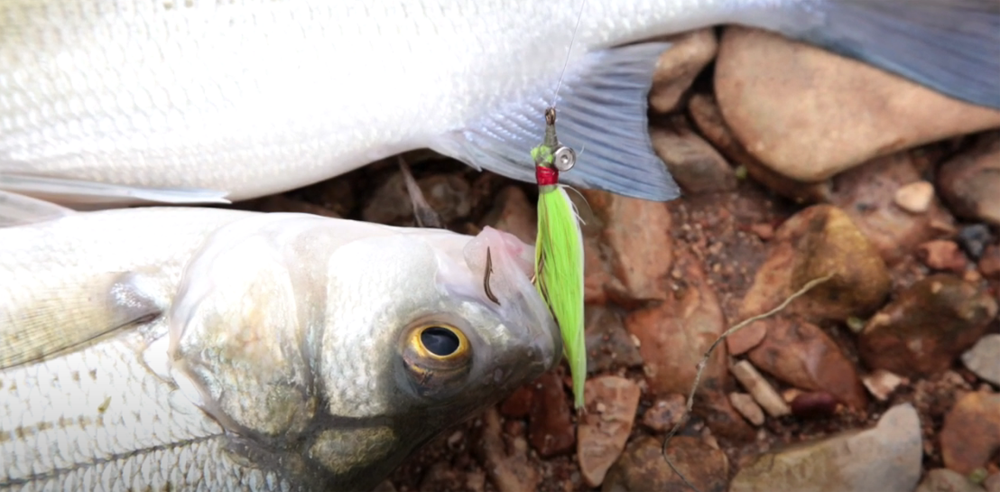
Scientific Name: Morone chrysops – White bass are very prolific. One female can produce up to one million eggs. Reproductive activities are triggered by water temperatures of 50 to 55 degree F. Spawning is at random over weeds, debris and rocks. When tributary streams are available, this species prefers upstream migration for spawning. No parental care is provided to eggs or young. Adult size: 10–18 inches Distribution: Native to the Tennessee River basin; introduced to rivers and lakes throughout the state, but scarce on the coastal plain. YouTube image – Tulsa TV.
Spring is here again – and so are the white bass!

Steve Hudson, former field editor for Fly Life Magazine.com, at a local North Georgia fly shop – promoting fly tying. A Trent Sizemore image.
By Steve Hudson
In many parts of the country, white bass runs (like robins in the yard or new leaves on trees) are proof that it’s really spring. My dad always said that these bass show up in rivers and creeks about the time the dogwoods bloom, at least here in north Georgia where I live.
No matter where you do your fishing, it’s warming water and lengthening days and increasing flows that cue these great fly rod fish to move up from lakes to spawn in feeder streams.
When the white bass runs happen, the numbers of fish in a given river can go from zero to zillions almost overnight. The numbers can be truly astounding. Males in the half- to 2-pound range come first; the larger females comes a few weeks later.
But the really good news is that they love to hit light-colored streamers. For the fly fisher, it doesn’t get much better than that
Where can you fish for these scrappy and enthusiastic fighters? If you have them where you live, look for them in rivers and other tributaries that feed large lakes. White bass are ambush predators, and you’ll find that they tend to congregate below shoals, near the mouths of creeks, near brush piles, close to sandbars, or near any other obstruction that breaks the flow of the stream. Such areas can hold large numbers of fish at the peak of the runs, and if you hook one in a given spot then you’ll want to stay with that spot for a while. It’s not unusual to hook a half dozen or more fish before that particular school wises up and moves on.
What will you need to fish for white bass? Rod-wise, I use a 9-ft. 6-wt. rod to easily cast the relatively heavy flies and to deal with the ubiquitous windy days of spring. That rod comfortably handles the typical white bass, too, and it gives me some reserve fish-fighting ability for those occasions where the occasional big hybrid or striper takes the fly instead.
How about line?
Remember that you’re fishing subsurface. In wadable water, I usually use either a floating or intermediate-tip line with a 9-foot 2X or 3X (depending on the size of the fly I’m using) tapered leader. These fish are not leader-shy. The floating line also makes it easy to switch to topwater flies should I decide to pursue other species with popping bugs or other surface flies at some point in the day.
In deeper waters, where I’m on a dedicated white bass expedition, I might go with an intermediate or sink-tip line instead. I’ll often pair that with a much shorter leader in the 5-foot range. In fact, for the leader, I may need nothing more elaborate than a couple of yards of straight 8- to 12-lb. mono.
As for flies, the key is “bright and flashy.” Streamers such as the Rolex or a white Clouser (maybe with some extra flash thrown in) are ideal. Even a white Woolly Bugger will work, but you’ll want to weight it so that it sinks well. In any case, streamers for white bass should be about two inches long (though longer versions will work too and may help you fool a big hybrid or even an early striper).

Streamers such as the Rolex or a white Clouser (maybe with some extra flash thrown in) are ideal. Even a white Woolly Bugger will work, but you’ll want to weight it so that it sinks well. In any case, streamers for white bass should be about two inches long (though longer versions will work too and may help you fool a big hybrid or even an early striper).
Anything else fly-wise? Well, a little touch of red never hurts
In fact, one of my favorite white bass flies is a homegrown creation that my friends call the Red-Nosed Yeti. Its most prominent feature is (you guessed it) a very prominent red nose, and it’s probably accounted for more of my own white bass catches than any other pattern.
How do you present these flies?
Remember that white bass are ambush predators. They’ll hold near cover in the lower part of the water column, so you want to get your fly down where they are hanging out as quickly as you can. To that end, I prefer sparsely dressed flies that are weighted with heavy metal eyes, several turns of weighting wire, or both. Other get-down techniques can also be used, among them sinking or of course intermediate or sink-tip lines.
In any case, cast close to cover, count the fly down to find the depth, and retrieve with a steady strip-strip-strip. I make my strips between 8-inches and a foot in length, and I keep the stripping rhythm steady. Keep your rod tip low so you have a straight connection with the fly, and that’s about all there is to it!

YouTube: How to catch white bass: Fly-fishing at Horseshoe Bend in Oklahoma TULSA TV.
Because white bass are so much fun to catch, and probably also because they’re really pretty good eating, don’t be surprised to find good white bass water crowded with other anglers. Unless you can fish during the middle of the week, you probably won’t find solitude during the peak of the run. But that’s okay. There are plenty of fish, and everyone seems to be having a good time. Go with the flow, cast to the cover, and have a great time.
In most areas, the white bass action will continue well into April before the fish return to the depths of the lakes and move out of reach for most fly fishers. But while it’s on, the white bass runs offer a great opportunity for unforgettable fishing.
For the next few weeks, odds are I’ll be out there somewhere every chance I get. And holler if you hook a big one. I’ll come running and take your picture!
About author, fly tyer, and angler Steve Hudson:
Steve is well known in the Southeast for his books on fly tying, hiking Appalachia, fly fishing, fly rod building, and creative writing professorship at local colleges. Click here to see his published works . . .

